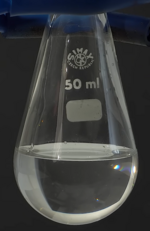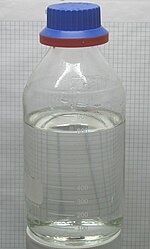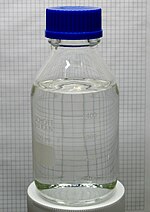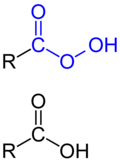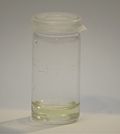A mineral acid (or inorganic acid) is an acid derived from one or more inorganic compounds, as opposed to organic acids which are acidic, organic compounds...
2 KB (238 words) - 19:40, 27 April 2024
Nitric acid is the inorganic compound with the formula HNO3. It is a highly corrosive mineral acid. The compound is colorless, but samples tend to acquire...
46 KB (5,165 words) - 17:24, 27 May 2024
and salts, strong mineral acids can directly be distilled. One important invention that resulted from the discovery of the mineral acids is aqua regia, a...
38 KB (4,078 words) - 12:21, 1 June 2024
acid (American spelling and the preferred IUPAC name) or sulphuric acid (Commonwealth spelling), known in antiquity as oil of vitriol, is a mineral acid...
65 KB (7,197 words) - 08:02, 1 June 2024
Perchloric acid is a mineral acid with the formula HClO4. Usually found as an aqueous solution, this colorless compound is a stronger acid than sulfuric acid, nitric...
13 KB (1,150 words) - 04:27, 30 May 2024
boracic acid. It is usually encountered as colorless crystals or a white powder, that dissolves in water, and occurs in nature as the mineral sassolite...
47 KB (4,989 words) - 20:30, 1 June 2024
anti form syn form Nitrous acid is usually generated by acidification of aqueous solutions of sodium nitrite with a mineral acid. The acidification is usually...
12 KB (1,198 words) - 01:04, 22 May 2024
Butyric acid Folic acid In general, organic acids are weak acids and do not dissociate completely in water, whereas the strong mineral acids do. Lower molecular...
8 KB (985 words) - 00:48, 25 April 2024
examples of monoprotic acids in mineral acids include hydrochloric acid (HCl) and nitric acid (HNO3). On the other hand, for organic acids the term mainly indicates...
47 KB (5,955 words) - 16:07, 22 April 2024
material. Levulinic acid is separated from the mineral acid catalyst by extraction. Levulinic acid is purified by distillation. Levulinic acid is used as a precursor...
8 KB (779 words) - 06:02, 20 April 2024
reaction. Hydrofluoric acid was first prepared in 1771, by Carl Wilhelm Scheele. It is now mainly produced by treatment of the mineral fluorite, CaF2, with...
21 KB (1,997 words) - 18:12, 1 June 2024
fluorescence, radioactivity, as well as its taste or smell and its reaction to acid. Minerals are classified by key chemical constituents; the two dominant systems...
110 KB (13,012 words) - 21:01, 19 May 2024
is 8.77 mol/L. Hydrobromic acid is one of the strongest mineral acids known. Hydrobromic acid is mainly used for the production of inorganic bromides...
7 KB (481 words) - 18:15, 1 June 2024
Phosphoric acid is produced industrially by one of two routes, wet processes and dry. In the wet process, a phosphate-containing mineral such as calcium...
27 KB (2,328 words) - 17:27, 17 April 2024
derived from conventional mineral acids, especially sulfuric acid, and the peroxy derivatives of organic carboxylic acids. They are generally strong...
6 KB (600 words) - 01:10, 7 November 2023
Carbonic acid is a chemical compound with the chemical formula H2CO3. The molecule rapidly converts to water and carbon dioxide in the presence of water...
21 KB (2,134 words) - 22:26, 21 May 2024
Hypophosphoric acid is a mineral acid with the formula H4P2O6, with phosphorus in a formal oxidation state of +4. In the solid state it is present as the...
6 KB (600 words) - 00:23, 22 May 2024
mostly fatty acids, that can be separated from a sample after splitting with a mineral acid, usually hydrochloric acid. The fatty acids most commonly...
2 KB (245 words) - 18:39, 1 February 2024
carboxylate anion of lactobionic acid is known as lactobionate. As an acid, lactobionic acid can form salts with mineral cations such as calcium, potassium...
3 KB (204 words) - 23:36, 17 October 2022
commonly as the (R)-enantiomer, but racemizes at 300 °C. When warmed with mineral acid, limonene isomerizes to the conjugated diene α-terpinene (which can also...
19 KB (1,519 words) - 20:48, 19 May 2024
Chelation (redirect from Chelated mineral)
chelates such as ethylenediaminetetraacetic acid (EDTA) proved too stable and not nutritionally viable. If the mineral was taken from the EDTA ligand, the ligand...
25 KB (2,840 words) - 14:16, 25 May 2024
hexafluorosilicic acid are often described as H 2SiF 6. Hexafluorosilicic acid is produced commercially from fluoride-containing minerals that also contain...
15 KB (1,238 words) - 23:03, 21 May 2024
hypochlorous acid, producing chloric acid and hydrogen chloride: 3 HClO → HClO3 + 2 HCl Chlorate Hypochlorous acid Chlorous acid Perchloric acid Oxidizing acid Dichlorine...
4 KB (243 words) - 15:24, 3 November 2023
Cleaning agent (section Acidic)
surfactants and corrosion inhibitors are added to the acid. Hydrochloric acid is a common mineral acid typically used for concrete. Vinegar can also be used...
12 KB (1,346 words) - 19:06, 23 May 2024
Hypochlorous acid is an inorganic compound with the chemical formula ClOH, also written as HClO, HOCl, or ClHO. Its structure is H−O−Cl. It is an acid that forms...
48 KB (5,432 words) - 03:28, 27 May 2024
others of which are vitamins, essential fatty acids, and essential amino acids. The five major minerals in the human body are calcium, phosphorus, potassium...
37 KB (3,054 words) - 09:36, 1 June 2024
sawdust, followed by acidification of the oxalate by mineral acids, such as sulfuric acid. Oxalic acid can also be formed by the heating of sodium formate...
41 KB (4,104 words) - 18:20, 31 May 2024
Aqua regia (redirect from Nitrohydrochloric acid)
Latin, "regal water" or "royal water") is a mixture of nitric acid and hydrochloric acid, optimally in a molar ratio of 1:3. Aqua regia is a fuming liquid...
17 KB (1,834 words) - 14:53, 9 May 2024
Hydrazoic acid used primarily for preservation of stock solutions, and as a reagent Hydrochloric acid a highly corrosive, strong mineral acid with many...
15 KB (264 words) - 18:51, 14 August 2022
and steroid ketones. DDQ decomposes in water, but is stable in aqueous mineral acid. Synthesis of DDQ involves cyanation of chloranil. J. Thiele and F. Günther...
7 KB (507 words) - 07:26, 15 April 2024

